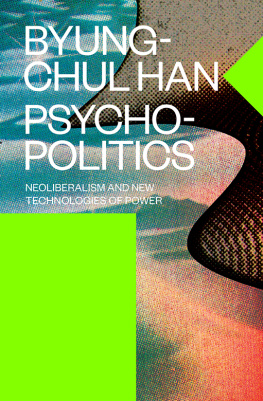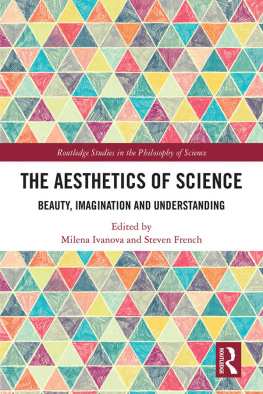Contents
Guide
Pages

Saving Beauty
Byung-Chul Han
Translated by Daniel Steuer
polity
First published in German as Die Errettung des Schnen S. Fischer Verlag
GmbH, Frankfurt am Main, 2015
This English edition Polity Press, 2018
Polity Press
65 Bridge Street
Cambridge CB2 1UR, UK
Polity Press
101 Station Landing, Suite 300,
Medford, MA 02155, USA
All rights reserved. Except for the quotation of short passages for the purpose of criticism and review, no part of this publication may be reproduced, stored in a retrieval system or transmitted, in any form or by any means, electronic, mechanical, photocopying, recording or otherwise, without the prior permission of the publisher.
Extracts on pages vi and 77 from Paul Celan: Selected Poems, Author: Paul Celan, translated by: Michael Hamburger, 1972. Reproduced with the kind permission of Johnson & Alcock Ltd.
ISBN-13: 978-1-5095-1513-4
A catalogue record for this book is available from the British Library.
Library of Congress Cataloging-in-Publication Data
Names: Han, Byung-Chul, author.
Title: Saving beauty / Byung-Chul Han.
Description: English edition. Cambridge, UK; Malden, MA: Polity Press, [2017] Includes bibliographical references and index. Identifiers: LCCN 2017009266 (print) LCCN 2017030526 (ebook)
ISBN 9781509515127 (Mobi) ISBN 9781509515134 (Epub) ISBN 9781509515097 ISBN 9781509515103 (pb)
Subjects: LCSH: Aesthetics
Classification: LCC BH39 (ebook) LCC BH39 .H36 2017 (print) DDC 111/.85--dc23
LC record available at https://lccn.loc/gov/2017009266
The publisher has used its best endeavours to ensure that the URLs for external websites referred to in this book are correct and active at the time of going to press. However, the publisher has no responsibility for the websites and can make no guarantee that a site will remain live or that the content is or will remain appropriate.
Every effort has been made to trace all copyright holders, but if any have been inadvertently overlooked the publisher will be pleased to include any necessary credits in any subsequent reprint or edition.
For further information on Polity, visit our website: politybooks.com
Once,
I heard him,
he was washing the world unseen, nightlong, real.
One and Infinite, annihilated ied.
Light was. Salvation.
Paul Celan
Notes
Untitled poem from
Atemwende [
Breathturn], in Paul Celan,
Selected Poems, transl. Michael Hamburger (London: Penguin, 1996), p. 279.
The Smooth
The smooth is the signature of the present time. It connects the sculptures of Jeff Koons, iPhones and Brazilian waxing. Why do we today find what is smooth beautiful? Beyond its aesthetic effect, it reflects a general social imperative. It embodies todays society of positivity. What is smooth does not injure. Nor does it offer any resistance. It is looking for Like. The smooth object deletes its Against. Any form of negativity is removed.
The aesthetics of the smooth is also adopted by smartphones. The LG G Flex is even covered with a selfhealing skin which makes any scratch, that is, any trace of an injury, disappear within the shortest of times. It is invulnerable, so to speak. The artificial skin of this smartphone keeps it smooth at all times. It is also flexible and bendable, with a slight curvature so as to perfectly follow the contours of the face and back pocket. This adaptability and absence of resistance are essential characteristics of the aesthetics of the smooth.
Smoothness is not limited to the outside of the digital apparatus. Communication via a digital apparatus also appears smoothed out, as it is mostly polite remarks, even positivities, which are exchanged. Sharing and Like represent communicative means for smoothening. Negativities are eliminated because they represent obstacles to accelerated communication.
Jeff Koons, arguably the most successful living artist at present, is a master of smooth surfaces. Andy Warhol also professed his commitment to beautiful, smooth surfaces, but his art still had the negativity of death and disaster inscribed into it. His surfaces are not entirely smooth. The series Death and Disaster, for instance, still lives off negativity. In Jeff Koonss work, by contrast, there exists no disaster, no injury, no ruptures, also no seams. Everything flows in soft and smooth transitions. Everything appears rounded, polished, smoothed out. Jeff Koonss art is dedicated to smooth surfaces and their immediate effect. It does not ask to be interpreted, to be deciphered or to be reflected upon. It is an art in the age of Like.
Jeff Koons says that an observer of his works should only emit a simple Wow. It seems that his art does not require any judgement, interpretation or hermeneutics, no reflection or thought. It intentionally remains infantile, banal, imperturbably relaxed, disarming and disburdening. It has been emptied of any depth, any shallows, any profound sense. Thus, his motto is: to take the observer into your arms. Nothing is meant to shake, injure or shock the observer. Art, according to Jeff Koons, is nothing but beauty, joy and communication.
His smooth sculptures cause a haptic compulsion to touch them, even the desire to suck them. His art lacks a negativity that would demand distance. It is the positivity of smoothness alone that causes the haptic compulsion. It invites the observer to take an attitude without distance, to touch. An aesthetic judgement, however, presupposes a contemplative distance. The art of the smooth abolishes such distance.
Haptic compulsion and the desire to suck can only arise in an art of the smooth that is devoid of meaning. Hegel, who emphatically held on to the arts being meaningful, therefore limited the sensual in the arts to the two theoretical senses of sight and hearing. The smooth only conveys an agreeable feeling, which cannot be connected with any meaning or profound sense. It exhausts itself in a Wow.
In his Mythologies, Roland Barthes points out the haptic compulsion which is triggered by the new Citron D.S.:
It is well known that smoothness is always an attribute of perfection because its opposite reveals a technical and typically human operation of assembling: Christs robe was seamless, just as the airships of science-fiction are made of unbroken metal. The D.S. 19 has no pretensions about being as smooth as cake-icing, although its general shape is very rounded; yet it is the dove-tailing of its sections which interest the public most: one keenly fingers the edges of the windows, one feels along the wide rubber grooves which link the back window to its metal surround. There are in the D.S. the beginnings of a new phenomenology of assembling, as if one progressed from a world where elements are welded to a world where they are juxtaposed and hold together by sole virtue of their wondrous shape, which of course is meant to prepare one for the idea of a more benign Nature.
As for the material itself, it is certain that it promotes a taste for lightness in its magical sense . Here, the glass surfaces are not windows, openings pierced in a dark shell; they are vast walls of air and space, with the curvature, the spread and the brilliance of soap bubbles,
Jeff Koonss seamless sculptures also look like brilliant, weightless soap bubbles made of air and emptiness. Like the seamless D.S., they confer a feeling of perfection, of lightness in a magical sense. They embody a perfect and optimized surface without depth and shallows.















